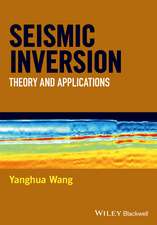Subsurface Conditions: Lecture Notes in Earth Sciences, cartea 99
Editat de Keith Turner, Michael Shaw Rosenbaumen Limba Engleză Paperback – 15 mai 2003
Subsurface geological modelling became an economic and technologic reality in the late 1980's, when competing 3-D geoscientific information systems were the subject of considerable research and evaluation, especially by the petroleum exploration industry. Investigations in the shallow subsurface impose additional requirements that have only recently become technically and economically achievable. The very shallow urban underground environment, where many infrastructure and utilities elements are located, presents the most difficult characterisation problems.
Subsurface modelling techniques have matured, along with modern data base concepts. The evolution of the Internet and Web-browser technologies has expanded information transmission and dissemination capabilities. Subsurface models are being integrated with decision-support systems to provide predictions of technical and economic performance. Yet even the most sophisticated of these models leave some uncertainty in geologic interpretation. A variety of techniques for assessing uncertainty have been developed and are being evaluated.
Din seria Lecture Notes in Earth Sciences
- 18%
 Preț: 944.99 lei
Preț: 944.99 lei -
 Preț: 402.38 lei
Preț: 402.38 lei - 15%
 Preț: 641.71 lei
Preț: 641.71 lei - 15%
 Preț: 637.46 lei
Preț: 637.46 lei - 15%
 Preț: 643.34 lei
Preț: 643.34 lei - 15%
 Preț: 644.82 lei
Preț: 644.82 lei - 15%
 Preț: 639.59 lei
Preț: 639.59 lei - 18%
 Preț: 1248.33 lei
Preț: 1248.33 lei - 15%
 Preț: 643.99 lei
Preț: 643.99 lei - 18%
 Preț: 1222.94 lei
Preț: 1222.94 lei - 18%
 Preț: 957.62 lei
Preț: 957.62 lei - 18%
 Preț: 1001.19 lei
Preț: 1001.19 lei -
 Preț: 384.48 lei
Preț: 384.48 lei - 18%
 Preț: 951.29 lei
Preț: 951.29 lei - 18%
 Preț: 954.45 lei
Preț: 954.45 lei - 15%
 Preț: 637.59 lei
Preț: 637.59 lei - 18%
 Preț: 943.43 lei
Preț: 943.43 lei - 18%
 Preț: 1228.29 lei
Preț: 1228.29 lei - 18%
 Preț: 950.33 lei
Preț: 950.33 lei - 18%
 Preț: 955.25 lei
Preț: 955.25 lei -
 Preț: 397.59 lei
Preț: 397.59 lei - 18%
 Preț: 946.55 lei
Preț: 946.55 lei - 23%
 Preț: 871.23 lei
Preț: 871.23 lei - 18%
 Preț: 1005.74 lei
Preț: 1005.74 lei - 15%
 Preț: 635.80 lei
Preț: 635.80 lei - 18%
 Preț: 943.08 lei
Preț: 943.08 lei - 18%
 Preț: 946.41 lei
Preț: 946.41 lei -
 Preț: 382.57 lei
Preț: 382.57 lei - 18%
 Preț: 957.62 lei
Preț: 957.62 lei
Preț: 950.96 lei
Preț vechi: 1159.71 lei
-18% Nou
Puncte Express: 1426
Preț estimativ în valută:
181.99€ • 189.30$ • 150.24£
181.99€ • 189.30$ • 150.24£
Carte tipărită la comandă
Livrare economică 14-28 aprilie
Preluare comenzi: 021 569.72.76
Specificații
ISBN-13: 9783540437765
ISBN-10: 3540437762
Pagini: 424
Ilustrații: XXVI, 398 p. 182 illus.
Dimensiuni: 155 x 235 x 22 mm
Greutate: 0.6 kg
Ediția:2003
Editura: Springer Berlin, Heidelberg
Colecția Springer
Seria Lecture Notes in Earth Sciences
Locul publicării:Berlin, Heidelberg, Germany
ISBN-10: 3540437762
Pagini: 424
Ilustrații: XXVI, 398 p. 182 illus.
Dimensiuni: 155 x 235 x 22 mm
Greutate: 0.6 kg
Ediția:2003
Editura: Springer Berlin, Heidelberg
Colecția Springer
Seria Lecture Notes in Earth Sciences
Locul publicării:Berlin, Heidelberg, Germany
Public țintă
ResearchCuprins
Fundamentals.- Characterisation of the shallow subsurface: implications for urban infrastructure and environmental assessment.- Bridging the gap between geoscience providers and the user community.- Definition of the modelling technologies.- New paradigms for geoscience information management.- End-User Requirements.- Putting the user first: implications for subsurface characterisation.- What are the end-user issues? Settlement risk management in underground construction.- Data requirements for geo-environmental management: end-user and producer perspectives for a harbour.- A decision support system for groundwater: water management issues for opencast mining.- Model Construction and Visualisation.- Visualisation: are the images really useful?.- Numerical schemes for process simulation: software for coupling pattern recognition to process modelling.- Regional subsurface models and their practical usage.- Slope stability estimation using GIS.- Using 2D GIS for the 3D reconstruction of the Corno Zuccone sackung, Val Taleggio (Italy).- Sedimentation modelling: data analysis in Rotterdam Harbour.- Fluid flow in fractured formations.- Effect of strain-softening on settlement due to tunnelling in soft soil.- Dissemination Strategies.- Dissemination of geoscience data: societal implications.- An economic model for the dissemination of national geological survey products and services.- Access to national geoscience repositories using digital geoscience spatial models.- Dissemination and visualisation of earth system models for the Dutch subsurface.- Property Prediction.- Total Geological History: a web-based modelling approach to the anticipation, observation and understanding of site conditions.- 3D modelling system for ground engineering.- Rock mass quality assessment based on deformation: experience from recent tunnels.- Improving subsurface parameter estimation through guiding geophysical inversions with a priori geological data.- Characterisation of void space utilising pore network models.- Assisting data interpretation: the cone penetration test.- Managing Uncertainty.- Impact of geoinformatics on the emerging Geoscience Knowledge Integration Paradigm.- Assessment of uncertainties in volume and yield estimations of clastic deposits.- Uncertainty with characterisation of soils.- Analysing uncertainty when modelling geological structures.- Uncertainty characterisation: reliability methods for slope stability.- The Way Ahead.- Current themes, issues and challenges concerning the prediction of subsurface conditions.- The Global Geoscientific Knowledge Network: overcoming the impediments to subsurface characterisation.
Textul de pe ultima copertă
Characterisation of the shallow subsurface provides civil, geotechnical and environmental applications with precise definitions of geomechanical and geohydrological properties. Over the past decade, the rapid pace of technological innovation has outstripped the ability of many researchers and potential users to evaluate and adopt promising new characterisation methods. Modern information technologies and information management concepts provide the basis of new paradigms and applications. This book defines future research needs for geological modelling and ground characterisation, including better dialogue between data provides and users and faster, better and less expensive methods for the creation and dissemination of subsurface characterisations.
Caracteristici
Includes supplementary material: sn.pub/extras









